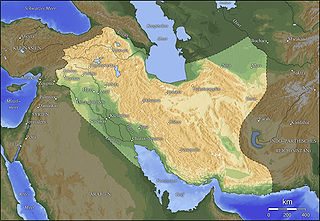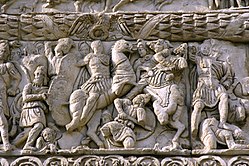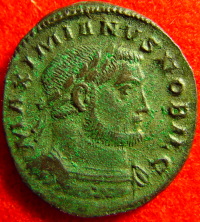The 290s decade ran from January 1, 290, to December 31, 299.

Year 299 (CCXCIX) was a common year starting on Sunday of the Julian calendar. In the Roman Empire, it was known as the Year of the Consulship of Diocletian and Maximian. The denomination 299 for this year has been used since the early medieval period, when the Anno Domini calendar era became the prevalent method in Europe for naming years.

Year 296 (CCXCVI) was a leap year starting on Wednesday of the Julian calendar. In the Roman Empire, it was known as the Year of the Consulship of Diocletian and Constantius. The denomination 296 for this year has been used since the early medieval period, when the Anno Domini calendar era became the prevalent method in Europe for naming years.

Galerius Valerius Maximianus was Roman emperor from 305 to 311. During his reign he campaigned, aided by Diocletian, against the Sasanian Empire, sacking their capital Ctesiphon in 299. He also campaigned across the Danube against the Carpi, defeating them in 297 and 300. Although he was a staunch opponent of Christianity, Galerius ended the Diocletianic Persecution when he issued the Edict of Toleration in Serdica (Sofia) in 311.

Shapur II, also known as Shapur the Great, was the tenth Sasanian King of Kings (Shahanshah) of Iran. He took the title at birth and held it until his death at age 70, making him the longest-reigning monarch in Iranian history. He was the son of Hormizd II.

Narseh was the seventh Sasanian King of Kings of Iran from 293 to 303.
Pap was king of Armenia from 370 until 374/375, and a member of the Arsacid dynasty. His reign saw a short, but notable period of stabilization after years of political turmoil. Although Armenia had been conquered and devastated by the Sassanid king Shapur II in 367/368, Pap was restored to the throne at a young age with Roman assistance in 370. Early in his reign, Armenia and Rome won a joint victory over the Persians at the Battle of Bagavan, and some former territories of the kingdom were reconquered by the efforts of his sparapet (general-in-chief) Mushegh Mamikonian. Although Pap's reign began with a reconciliation of the monarchy, nobility and church, his relations with the church soon deteriorated. Pap allegedly had the Patriarch of Armenia, Nerses I, poisoned, although some later historians doubt this narrative. Pap also eventually ran afoul of the Romans, who suspected him of colluding with the Persians. The emperor Valens unsuccessfully attempted to assassinate him in 373/374, but ultimately succeeded in having him killed in 374/375. He was succeeded by his nephew Varazdat as king.
The Roman–Persian Wars, also known as the Roman–Iranian Wars, were a series of conflicts between states of the Greco-Roman world and two successive Iranian empires: the Parthian and the Sasanian. Battles between the Parthian Empire and the Roman Republic began in 54 BC; wars began under the late Republic, and continued through the Roman and Sasanian empires. A plethora of vassal kingdoms and allied nomadic nations in the form of buffer states and proxies also played a role. The wars were ended by the early Muslim conquests, which led to the fall of the Sasanian Empire and huge territorial losses for the Byzantine Empire, shortly after the end of the last war between them.
Khosrov III the Small was the king of Arsacid Armenia c. 330–338/339.
Arshak II, also written as Arsaces II, was an Arsacid prince who was King of Armenia from 350 until c. 364/367. Although Arshak's reign opened with a period of peace and stability, it was soon plagued by his conflicts with the Armenian church and nobility, as well as a series of wars between Rome and Persia, during which the Armenian king teetered between the warring sides. Arshak participated in the Roman emperor Julian's ill-fated campaign against Persia; after the consequent Perso-Roman Treaty of 363, Armenia was left to fend for itself against a renewed attack by the Persian king Shapur II. Faced with defections and rebellions among the Armenian nobility, Arshak was lured to Persia for peace negotiations with Shapur, after which he was imprisoned in the Castle of Oblivion in Khuzistan and is said to have committed suicide in captivity. Arshak's reign was followed by the conquest and devastation of Armenia by the Persians, although his son and heir Pap managed to escape and later ascended to the Armenian throne with Roman assistance.

Mushegh I Mamikonian was an Armenian military officer from the Mamikonian family who occupied the hereditary office of sparapet (generalissimo) of the Kingdom of Armenia under the Arsacid kings Pap and Varazdat. He took part in the Armenian resistance against the forces of the Sasanian monarch Shapur II, notably taking part in the Battle of Bagavan, where the Iranian forces were defeated. He was the regent of Armenia under the young and inexperienced Varazdat, who eventually suspected him of posing a danger to his rule, and thus had him executed, in 377/8.
The Peace of Nisibis of 299, also known as the First Peace of Nisibis, was a peace treaty signed in 299 by the Roman and Sasanian empires, and concluded the Roman–Sasanian War of 296–299. The border established as a result of the treaty was maintained until the Second Peace of Nisibis of 363.
Romans in Persia is related to the brief invasion and occupation of western and central areas of Parthia by the Romans during their empire. Emperor Trajan was even temporarily able to nominate a king of western parts of Parthia, Parthamaspates, as ruler of a Roman "client state" in Parthia.

The Battle of Bagavan or the Battle of Vagabanta was fought in 371 near the settlement of Bagavan, in the district of Bagrevand in Greater Armenia, between a joint Roman-Armenian force and a Sassanid army, with the Romans and Armenians emerging victorious. It is recorded by the Roman historian Ammianus Marcellinus, as well as the Armenian historian Faustus of Byzantium.

Julian's Persian expedition began in March 363 AD and was the final military campaign of the Roman emperor Julian. The Romans fought against the Sasanian Empire, ruled at the time by Shapur II.

The Battle of Carrhae, also known as the Battle of Callinicum, took place in 296 or 297, after the invasion of Mesopotamia and Armenia by the Sasanian king Narseh. The battle took place between Carrhae (Harran) and Callinicum (al-Raqqah) and was a victory for the Sasanians. Narseh attacked with forces recruited from the Euphrates frontier. He managed to defeat his opponent by good timing.

Arbāyistān or Beth Arabaye was a Sasanian province in Late Antiquity. Due to its situation and its road systems, the province was a source of income from commercial traffic, as well as a constant area of contention during the Roman–Persian Wars.

The Sassanid Empire or Sassanian Dynasty is the name used for the Persian dynasty which lasted from 224 to 651 AD.
The Perso-Roman wars of 337–361 were a series of military conflicts fought between the Roman Empire and the Sasanian Empire between 337 and 361. They were a result of long-standing competition between the rival powers over influence in the border kingdoms of Armenia and Iberia, as well as the desire of Shapur II, after his Arab campaign, to revoke the unfavorable terms of the Treaty of Nisibis, which had concluded the previous war between the empires. Though the Romans under Constantius II were defeated in several sanguinary encounters, Shapur was unable to secure a decisive victory.
Surena was a 4th-century Iranian military officer active during the reign of the Sasanian king (shah) Shapur II. He played an important role in the denial of the Roman invasion in 363 and the peace negotiations that followed.













